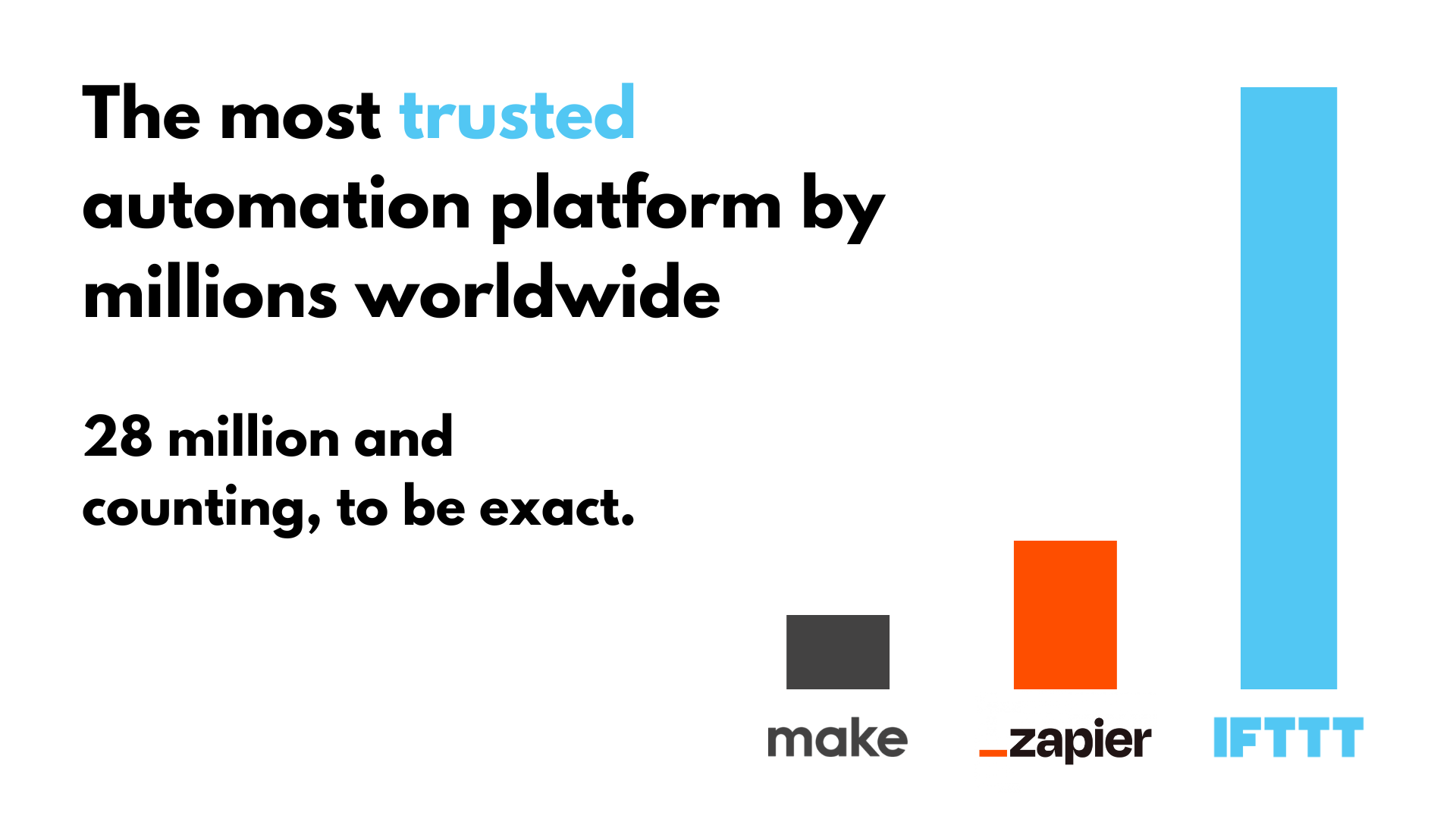Small teams are known for their agility, flexibility, and ease to manage. Many blooming businesses you know and love have a much smaller team than you may think, such as IFTTT, which has never had more than 100 employees. However, without a concrete system in place, managing tasks and projects in a small team can be incredibly difficult.
In today's fast-paced world, where there's so much to do in so little time, task/project management tools can be a game-changer for small teams. In this blog, we will introduce and compare two popular project management tools that can help you streamline workflows, improve productivity, and achieve your small teams’ goals with ease: ClickUp and Jira. We'll also discuss the time-saving hero for the day: IFTTT, which can integrate with both ClickUp and Jira and thousands of other apps and serviced.
Well, what is Clickup and what is Jira?
ClickUp is a cloud-based platform that combines project management and task management in one place. This platform allows users to create different workspaces, projects, and lists to manage and organize their to-dos.
On the other hand, Jira is a software development tool that is widely used by organizations to manage software projects, track issues, and collaborate with team members. Additionally, Jira offers numerous features that make it an excellent tool for project management, Agile software development, and issue tracking.
Integrations and automation are essential features for project management tools to make sure processes go swiftly and smoothly, and both ClickUp and Jira offer integration with a variety of third-party applications such as Google Drive, Dropbox, and Trello. Automation features like when to execute triggers are also available in both tools, allowing team members to eliminate mundane tasks to increase productivity.
ClickUp vs. Jira - Key differences

While both tools are feature-rich and can help you organize and manage your team's work, they have distinct differences that can make one better suited to your team's needs than the other.
One key difference between ClickUp and Jira is user experience. ClickUp was designed to be an all-in-one platform that combines task management, time tracking, collaboration, and more. It uses a sleek and modern interface that is intuitive and easy to navigate. Jira, on the other hand, has a steeper learning curve and a more complex interface. Jira offers more customization and advanced features, which can be overwhelming for small teams without technical expertise, specifically agile methodologies. For example, Jira offers Advanced Roadmaps that allows teams to plan and track across multiple projects, with a wide range of outlines and features, such as board(s) issues (scrum or kanban), project(s) issues, and filter(s) issues.
Additionally, Jira is known for its customization options, allowing users to create their own workflows and fields. This can be great for larger teams with complex projects and specific needs. However, for small teams with simpler projects, ClickUp's pre-built templates and fields may be sufficient. ClickUp also allows for some customization, but not to the same extent as Jira.
Cost comparison: ClickUp vs Jira
When comparing the cost of ClickUp and Jira, they are both within the same price point. ClickUp offers a wider range of pricing plans with no user limits for their free plan, while Jira offers two different plans, with a limit of 10 users for their free plan. Let’s dive deeper into the specifics for each pricing plan.
ClickUp software pricing (Monthly)

Unlimited Plan ($10 per member per month): In addition to ClickUp’s Free Forever plan, the Unlimited Plan offers features like unlimited storage, integrations, dashboards, Gantt charts, custom fields, agile reporting, permissions for guests, column calculations, and many more. This plan is ideal for small teams needing more robust project management without breaking the bank.
Business Plan ($19 per member per month): This plan includes everything in the Unlimited plan and more. It offers Google SSO, unlimited teams, custom exporting, advanced automations, additional dashboard features, time tracking, public sharing, advanced timelines, mind maps, and granular time estimates. It’s well-suited for growing businesses with increasing project complexities.
Enterprise (Pricing varies): The Enterprise plan is customized based on the size and specific needs of your organization. It includes everything from the Business Plus plan, along with white labeling, advanced permissions, enterprise-level API, Single Sign-On (SSO), live onboarding training, unlimited custom roles, and additional security and support options.
Jira software pricing (50 users)

Free Plan: Jira’s Free plan supports up to 10 users with access to unlimited projects and tasks, dashboards, and 2GB of storage. It’s great for small teams starting with project management tools but comes with limited features and storage capacity.
Standard Plan ($8.15 per user per month): In addition to everything in the Free plan, the Standard plan includes support for up to 35,000 users, project roles, 250GB of storage, and business-hour support. It offers expanded functionality for growing teams needing more capacity and flexibility.
Premium Plan ($16.00 per user per month): The Premium plan includes advanced features such as automation across multiple projects, advanced roadmaps, dependency management, unlimited storage, and 24/7 premium support. It's designed for teams handling more complex projects with higher requirements for collaboration.
Enterprise (Pricing varies): Jira’s Enterprise plan is built for large organizations and offers enterprise-grade security, compliance, governance, and support. It includes all Premium features with tailored services to meet the needs of large-scale businesses. Pricing depends on team size and specific requirements.
Set-up comparison

Both ClickUp and Jira offer relatively easy set-up processes. However, ClickUp may be the easier of the two to set up due to its user-friendly interface that’s easy to navigate. Additionally, when teams first get started, they jump right in to setting up their boards/lists for their project tasks without needing to experiment with customization as much as pre-built templates are offered.
On the other hand, Jira has extensive features and customization which can be difficult for those who aren’t experienced/familiar with project management software and/or software development. Although Jira may have a steeper learning curve due to its more complex interface, users have access to more customization where they can create custom fields and workflows to fit specific team needs.
Feature comparison
ClickUp features
- ClickApps: customize your team’s experience within your workspace
- Tracking, calendars, and goal tracking capabilities, such as Gantt charts
- Allow guest/invitee and third party contractors access to your project
- Real-time reporting with Workload and Box views: see who is under or over capacity
Jira features
- Jira Query Language (JQL): allows users to search for issues that are unable to be found in basic searches
- Advanced Roadmaps: advanced project management and planning capabilities, such as planning and tracking across multiple teams/projects, map dependencies between teams/projects/initiatives, overlook multiple teams’ capacity on a sprint-by-sprint basis, and more
- Agile board: selection of issues in a column that represents a team’s workflow to completion
- Advanced configuration options
Automation & integration comparison
Although both ClickUp and Jira include workflow automation, using IFTTT can help get more out of the two. By integrating IFTTT with ClickUp and Jira, you can streamline project management tasks, automate repetitive tasks, improve communication processes, sync data across multiple platforms, and customize workflows to your specific needs.
You can integrate the two with countless services, such as Discord, Slack, Pipedrive, Asana, Evernote, and over 1000 more. As a result, you get more time to focus on vital tasks while increasing your productivity levels and project success.
Popular ClickUp automations & integrations:
-
Create ClickUp tasks from new iOS Reminders (& Siri)

-
Create ClickUp tasks from certain Google Calendar events

-
Quickly add new tasks in ClickUp by sending an email

Link to more IFTTT ClickUp Integrations: https://ifttt.com/clickup
Popular Jira automations & integrations
-
Create Jira issues from new Google Forms responses

-
Create detailed Google Calendar events from new issues in Jira

-
Post to a Discord channel for new Jira issues

Link to more IFTTT Jira Integrations: https://ifttt.com/jira
ClickUp vs. Jira - Which should a small team choose?
When it boils down to it, both ClickUp and Jira offer great project management solutions for businesses. However, the right choice for your team will depend on your team’s specific needs and preferences, whether that is user interface, ease of use, pricing, customization possibilities, integrations, etc. Jira is more aimed towards software developers, so keep that distinction in mind.
Additionally, more specific features to think over includes time tracking, calendar access, collaboration features, and project reporting. For example, collaboration is essential when working on projects as a team where there are features, such as file sharing, real-time team collaboration, and chat options.
To make things easier on your thought process, IFTTT’s pre-made automations and the option to create and personalize triggers to cater to your small teams’ needs and preferences can help you make your decision more confidently.
At IFTTT, our favorite app for small teams is ClickUp as it is our main platform for content planning and team collaboration for our small marketing team. With its easy-to-use and customizable dashboard, we can assign team members to tasks, set priorities, create deadlines for all projects, and track progress. When it comes to communication and collaboration, we can easily communicate individually or as a team with the mentions feature, communicating with Chat in real-time, and using comments to provide feedback on tasks, ask questions, or discuss ideas.
Better project management software with IFTTT

IFTTT, short for "If This Then That," is our free unique service that can enhance your project management workflow no matter which platform you choose. IFTTT can create powerful automated actions based on time, events, and triggers from a variety of organization and code tools.
IFTTT is our free web-based service and mobile app designed to boost productivity by automating tasks. It works by creating connections between over 1000 popular apps and services, allowing them to work together seamlessly. Best of all, you don't need any coding background to start with our user-friendly platform.
The basic idea behind IFTTT is to create "applets" or sets of instructions that trigger when certain conditions are met. This can be turning on the lights automatically when you enter your house, for example. These applets can be further expanded with filter code, query, and delay functions to allow you build powerful systems tailored to your needs.
Founded in 2011, IFTTT has been used by over 25 million individuals to automate both business and home tasks, saving time and increasing efficiency. It's commonly used to connect disparate services and systems, making all products and services work well together in a way that instills user confidence. Best of all, it's free and only takes a couple of minutes to set up.



